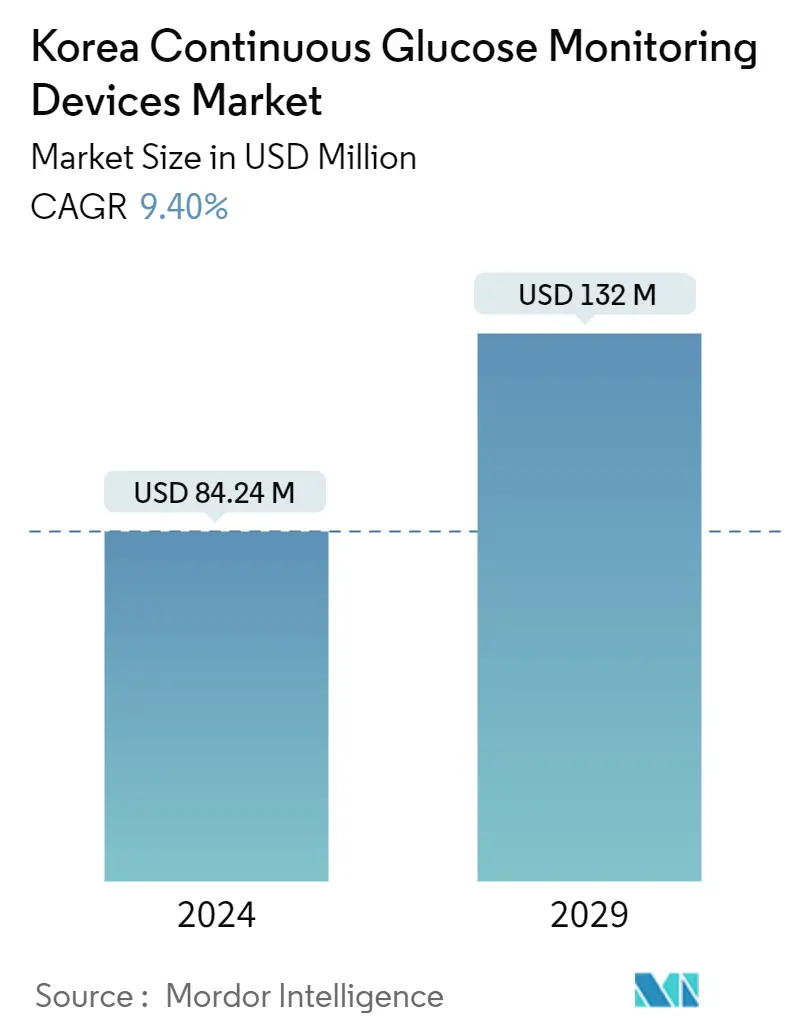Market Size of Korea Continuous Glucose Monitoring Devices Industry

| Study Period | 2018 - 2029 |
| Base Year For Estimation | 2023 |
| Market Size (2024) | USD 84.24 Million |
| Market Size (2029) | USD 132 Million |
| CAGR (2024 - 2029) | 9.40 % |
| Market Concentration | High |
Major Players
*Disclaimer: Major Players sorted in no particular order |
Korea Continuous Glucose Monitoring Devices Market Analysis
The Korea Continuous Glucose Monitoring Devices Market size is estimated at USD 84.24 million in 2024, and is expected to reach USD 132 million by 2029, growing at a CAGR of 9.40% during the forecast period (2024-2029).
Diabetes was one of the main comorbidities closely related to the risk of mortality and severe clinical outcomes in patients with COVID-19. Numerous epidemiological findings consistently suggested that the proportion of diabetes was higher in COVID-19 patients with a severe clinical course and that people with diabetes were also more vulnerable to COVID-19 infection than those without diabetes.
During the pandemic, health providers or diabetic patients were required to minimize contact and quarantine, and telehealth provided alternative support in preventing acute complications and controlling severe hyperglycemia. People with diabetes who were not infected with the SARS-CoV-2 were also recommended to maintain optimal glycemic control as part of the primary prevention of COVID-19.
The primary use of CGMS is for patients with type 1 or severe type 2 diabetes who are on insulin therapy. If insulin-dependent diabetics are dependent on SBGM, they should prick their fingers with needles up to 10 times a day to draw blood to measure blood glucose and, depending on the situation, inject insulin to avoid hyperglycemic or hypoglycemic shock. On the other hand, CGMS users can monitor their blood glucose changes for 1-7 days without any additional blood draw with a single sensor insertion.
The key factors propelling the market studied are increasing diabetes prevalence and the support initiatives taken by the Korean government.
Korea Continuous Glucose Monitoring Devices Industry Segmentation
A tiny sensor that is commonly implanted under the skin on the abdomen or arm is how a CGM functions. Diabetes patients' interstitial glucose level, or the glucose present in the fluid between their cells, is measured by the sensor. Every few minutes, the sensor measures the glucose. The data is wirelessly transmitted from a transmitter to a monitor. The Korean continuous glucose monitoring devices market is segmented by individual components such as sensors and durables (receivers and transmitters) and By Provinces. The report offers the value (in USD) and volume (in units) for the above segments.
| By Component | |
| Sensors | |
| Durables (Receivers and Transmitters) |
| By Provinces (Quantitative Analysis) | |
| Seoul | |
| Busan | |
| Daegu Metropolitan City | |
| Incheon Metropolitan City | |
| Gwangju | |
| Other Provinces |
Korea Continuous Glucose Monitoring Devices Market Size Summary
The Korea Continuous Glucose Monitoring Devices Market is poised for significant growth, driven by the increasing prevalence of diabetes and supportive government initiatives. The market is characterized by the adoption of continuous glucose monitoring systems, which offer a more convenient alternative to traditional blood glucose monitoring methods, particularly for insulin-dependent diabetics. These devices allow for continuous monitoring without the need for frequent blood draws, enhancing the quality of life for users. The market's expansion is further supported by the Korean National Health Insurance System, which facilitates access to these devices through insurance rebates, thereby encouraging their adoption among the diabetic population.
The market landscape is highly consolidated, with major players like Dexcom, Abbott, and Medtronic leading the charge through product innovations and strategic collaborations. Regulatory support from the Ministry of Food and Drug Safety, along with advancements in remote patient monitoring technologies, is expected to bolster market growth. The increasing awareness and availability of CGM devices, coupled with the rising incidence of diabetes, are key factors contributing to the market's upward trajectory. As the demand for effective diabetes management solutions grows, the market is set to witness robust expansion over the forecast period.
Korea Continuous Glucose Monitoring Devices Market Size - Table of Contents
-
1. MARKET DYNAMICS
-
1.1 Market Overview
-
1.2 Market Drivers
-
1.2.1 Rapidly Increasing Incidence and Prevalence of Diabetes
-
1.2.2 Technological Advancements in the Market
-
-
1.3 Market Restraints
-
1.3.1 Monopolized Supply Chain and High Cost of Devices
-
-
1.4 Industry Attractiveness - Porter Five Forces
-
1.4.1 Bargaining Power of Suppliers
-
1.4.2 Bargaining Power of Consumers
-
1.4.3 Threat of New Entrants
-
1.4.4 Threat of Substitute Products and Services
-
1.4.5 Intensity of Competitive Rivalry
-
-
1.5 Analysis of CGM Device Distribution Channels
-
1.6 Analysis of CGM Device Prescribers
-
-
2. Market Segmentation
-
2.1 By Component
-
2.1.1 Sensors
-
2.1.2 Durables (Receivers and Transmitters)
-
-
2.2 By Provinces (Quantitative Analysis)
-
2.2.1 Seoul
-
2.2.2 Busan
-
2.2.3 Daegu Metropolitan City
-
2.2.4 Incheon Metropolitan City
-
2.2.5 Gwangju
-
2.2.6 Other Provinces
-
-
Korea Continuous Glucose Monitoring Devices Market Size FAQs
How big is the Korea Continuous Glucose Monitoring Devices Market?
The Korea Continuous Glucose Monitoring Devices Market size is expected to reach USD 84.24 million in 2024 and grow at a CAGR of 9.40% to reach USD 132 million by 2029.
What is the current Korea Continuous Glucose Monitoring Devices Market size?
In 2024, the Korea Continuous Glucose Monitoring Devices Market size is expected to reach USD 84.24 million.

